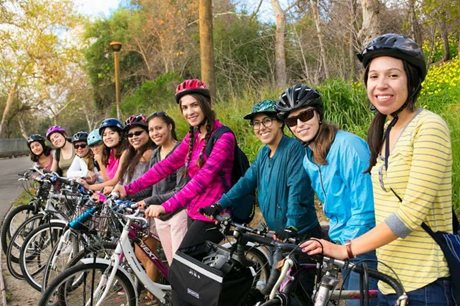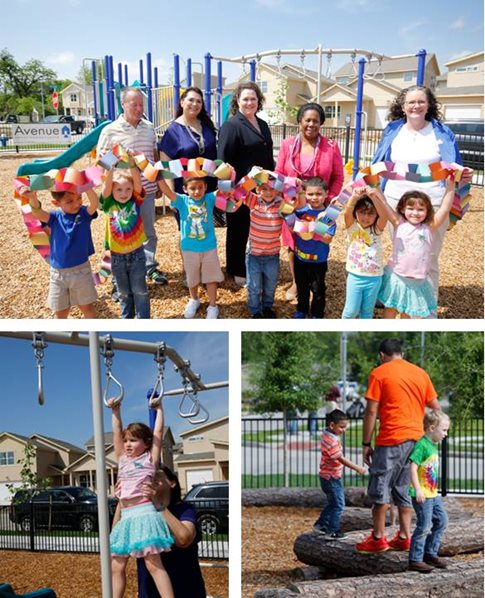How do you transform the built environment and the community culture that surrounds it to facilitate safe physical activity that promotes health? That’s a common challenge being tackled by both Avenue Community Development Corp. in Houston and NeighborWorks Orange County. Both are part of a healthy communities demonstration project that combines financial investments with peer-to-peer learning and coaching to build community health and well-being. This support from NeighborWorks America was possible in part due to a collaboration with the County Health Rankings & Roadmaps program and the Robert Wood Johnson Foundation.
For Avenue, a primary goal was to improve health, particularly by reducing childhood obesity. For NWOC, a major concern was safety, since Santa Ana has the third-highest rate of collisions involving pedestrians or bicyclists in the nation. However, both initiatives are focusing on safe spaces that promote physical activity. And both relied on a fundamental principle to achieve success: Residents must be front and center in choosing priorities and designing responses.
“We didn’t set out to do this just because it’s what the experts recommend. We didn’t just tell people we were going to make you healthier,” comments Jenifer Wagley, deputy director of Avenue CDC. “The residents themselves chose this as a priority. We asked what they are passionate about, and this is what they said. Make sure what you’re focusing on is community-driven.”
Improving outdoor safety
Of the seven largest cities in California, Santa Ana has the highest population density at more than 12,000 per square mile. It also has the youngest population, with a median age of 29 years. Add to those stats the fact that unemployment is 4-5 percent higher than the county as a whole—leading to a low median household income—and you have a recipe for another notable characteristic: The city has the 15th highest percentage of commuters who bicycle among the largest 70 U.S. cities and accounted for 23 percent of all county pedestrian fatalities in 2015.“It’s a really dense community in a small area,” explains Marina Ramirez, community-building coach for NWOC. “There also is a high number of immigrants making low incomes, so they are used to walking and often can’t afford bus passes, much less cars. On top of that, there is a lack of infrastructure that promotes safety, like sidewalks.”
 Key to the campaign to change this situation is a resident-led organization called Santa Ana Active Streets (SAAS). The idea for the organization was conceived in 2012, when NWOC send a team of resident leaders to NeighborWorks America’s Community Leadership Institute. The team decided to focus on the need for improved community health and safety, and for the next year worked to develop its mission, organizational structure, goals and activities. Today, NWOC serves as its fiscal intermediary and it reaches about 15,000 people a year through its activities. Its primary objectives are:
Key to the campaign to change this situation is a resident-led organization called Santa Ana Active Streets (SAAS). The idea for the organization was conceived in 2012, when NWOC send a team of resident leaders to NeighborWorks America’s Community Leadership Institute. The team decided to focus on the need for improved community health and safety, and for the next year worked to develop its mission, organizational structure, goals and activities. Today, NWOC serves as its fiscal intermediary and it reaches about 15,000 people a year through its activities. Its primary objectives are:
- Educating residents on “active transportation” for health and safety.
- Advocating for related improvements in city and county policies and infrastructure.
- “Activating” streets and other public spaces for pedestrian and bicyclist use.
“We get people involved first with a fun bike ride or walk,” says Ramirez. “Once they are hooked, we say that if they want to lead an activity themselves, they need to take one of our safety classes, which we offer in both Spanish and English. After that, we hope to cultivate them as participants in advocacy activities and leadership.”
Promoting health through exercise
Wagley says the secret to her organization’s success with community engagement is similar.“Our theory is that once individuals engage with others on a social level (such as at a party or festival), they are more likely to volunteer for small community-improvement projects. Once they have a successful volunteer experience and begin to create new relationships, they are more likely to take on larger volunteer roles and increase their civic participation,” she explains. “Each success builds on the last as individuals build their social capital and widen their circles to participate in larger-scale activities with wider impact. As more individuals become active, substantive, lasting social change becomes truly possible.”
Since 2009, Avenue has coordinated a highly successful community-building program in the Near Northside area called the Great Opportunities (GO) Neighborhoods. This comprehensive strategy for revitalizing low-income, vulnerable neighborhoods into healthy, sustainable communities began with an extensive “listening campaign” and planning process. From 2010-2014, Avenue brought dozens of stakeholder institutions together with thousands of residents to identify needs and develop initiatives to address them through collaboration and creativity.
The median income in the Near Northside is just 46 percent of that for Houston overall and one-third of the neighborhood’s residents live in poverty. At the same time, resources and opportunities to sustain healthy eating and exercise are limited; 57 percent of the children are overweight or obese.
 “Among the drivers of this high rate of obesity is a lack of infrastructure such as sidewalks, the perception of a high crime rate, fear of stray animals and habituation to a neighborhood where being outside just wasn’t part of the culture,” says Wagley.
“Among the drivers of this high rate of obesity is a lack of infrastructure such as sidewalks, the perception of a high crime rate, fear of stray animals and habituation to a neighborhood where being outside just wasn’t part of the culture,” says Wagley.Since then, however, 14,395 volunteers have invested 33,910 hours into planning and implementing more than 200 community-led projects related to public safety, education, youth development, arts, health and wellness, affordable housing and economic development. Among the activities have been a 15-mile bike tour (attracting 150 riders), weekly afterschool wellness activities (such as games and Zumba) for kids 8-13, and the construction of a KaBOOM! playground with community participation at a local church. Community-supported exercise programs and creation of safe spaces to play and exercise are scientifically supported methods for increasing physical activity, according to the “What Works for Health” database of health-equity strategies.
The goals are equally ambitions in the coming three years:
- Healthy food: Decrease the percentage of children with an unhealthy weight to 34 percent (in line with the city of Houston average).
- Healthy minds: Reduce the number of Near Northside residents reporting serious psychological distress from the current 11 percent to the city average of 7 percent.
- Healthy bodies: Reduce the number of Near Northside residents who lack health insurance from 37 percent to 25 percent.
- Healthy living: Double the miles of trails and on-street bikeways from six to 12 miles.

